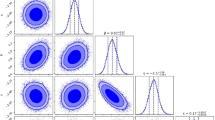The Robertson–Walker cosmological equation is generalized for the case of a flat world within the framework of the Kaluza–Klein theory in the absence of the cylindricity condition, which posits the hypothesis of a physical structure of the fifth dimension that can serve as a test object. The dependences of the Hubble parameter and the red shift parameter on the perturbation of the fifth dimension have been obtained here for the first time. A model of dark energy is proposed which treats it as the dynamic quintessence in the presence of a reactive potential, where the latter is the source of its effect upon gravitation.
Similar content being viewed by others
References
V.I. Dokuchaev, Model of Dark Energy [in Russian], Publishing House of Institute of Nuclear Physics of the Russian Academy of Sciences, Moscow (2010).
W. Pauli, Theory of Relativity, Courier Dover Publications, Mineola, New York (1958).
A. Einstein and P. G. Bergmann, Ann. Math., Princeton, 39, 683 (1938).
L. K. Martinson and E. V. Smirnov, Quantum Physics [in Russian], Publishing House of Bauman Moscow State Technical University, Moscow (2012).
Yu. G. Ignat’ev, Nonequilibrium Universe: Kinetic Models of Cosmological Evolution [in Russian], Kazan’ University Press, Kazan’ (2013).
V. M. Mostepanenko, Braz. J. Phys., 34, No. 1A (2004).
A. D. Chernin, Usp. Fiz. Nauk, 178, No. 3, 267–300 (2008).
V. N. Lukash and V. A. Rubakov, Usp. Fiz. Nauk, 178, 301–308 (2008).
E. G. Floratos and G. K. Leontaris, Phys. Lett., B465, 95 (1999).
A. Kehagias and K. Sfetsos, Phys. Lett., B472, 39 (2000).
N. N. Bogolyubov, Izv. Akad. Nauk SSSR, Ser. Fizich., 11, 77 (1947).
I. M. Khalatnikov, Theory of Superfluidity [in Russian], Nauka, Moscow (1971).
Yu. B. Rumer and M. Sh. Ryvkin, Thermodynamics, Statistical Physics, and Kinetics [in Russian], Nauka, Moscow (1977).
Yu. Rogozhin, J. Brit. Interplanet. Soc., 26, No. 8, 475–480 (1973).
U. N. Zakirov, Russ. Phys. J., 53, No. 2, 188–197 (2010).
D. K. Ross, Int. J. Theor. Phys., 25, 663 (1986).
A. Basu and D. Ray, Int. J. Theor. Phys., 28, No. 2, 227–229 (1989).
C. Møller, Theory of Relativity, Oxford University Press, Oxford, UK (1976).
S. F. Levin, in: Proc. International Conference PIRT-13 “Physical Interpretations of Relativity Theory” [in Russian], Moscow (2013).
P. S. Wesson, Modern Kaluza–Klein Theory, World Scientific, Singapore (2000).
E. Leibowitz and N. Rosen, Gen. Rel. Grav., 4, 449 (1973).
A. Einstein and M. Smoluchowski, Brownian Motion, Collected Works [Russian translation], Moscow; Leningrad (1936).
S. Perlmutter, in: Physics Today, American Institute of Physics (2003), S–0031–9228–0304–030–4.
Author information
Authors and Affiliations
Corresponding author
Additional information
Translated from Izvestiya Vysshikh Uchebnykh Zavedenii, Fizika, No. 3, pp. 39–43, March, 2014.
Rights and permissions
About this article
Cite this article
Zakirov, U.N. Robertson–Walker Cosmological Equations Within the Framework of the Kaluza–Klein Theory in the Absence of the Cylindricity Condition. Dark Energy Model. Russ Phys J 57, 328–333 (2014). https://doi.org/10.1007/s11182-014-0243-5
Received:
Published:
Issue Date:
DOI: https://doi.org/10.1007/s11182-014-0243-5




